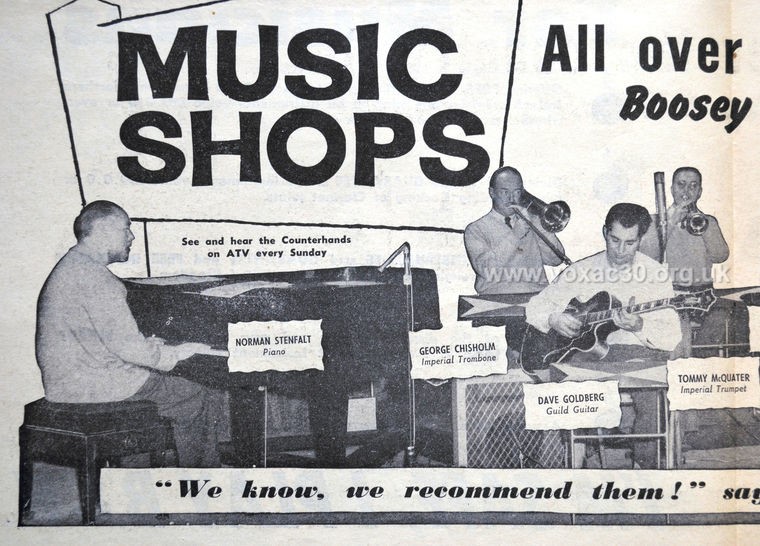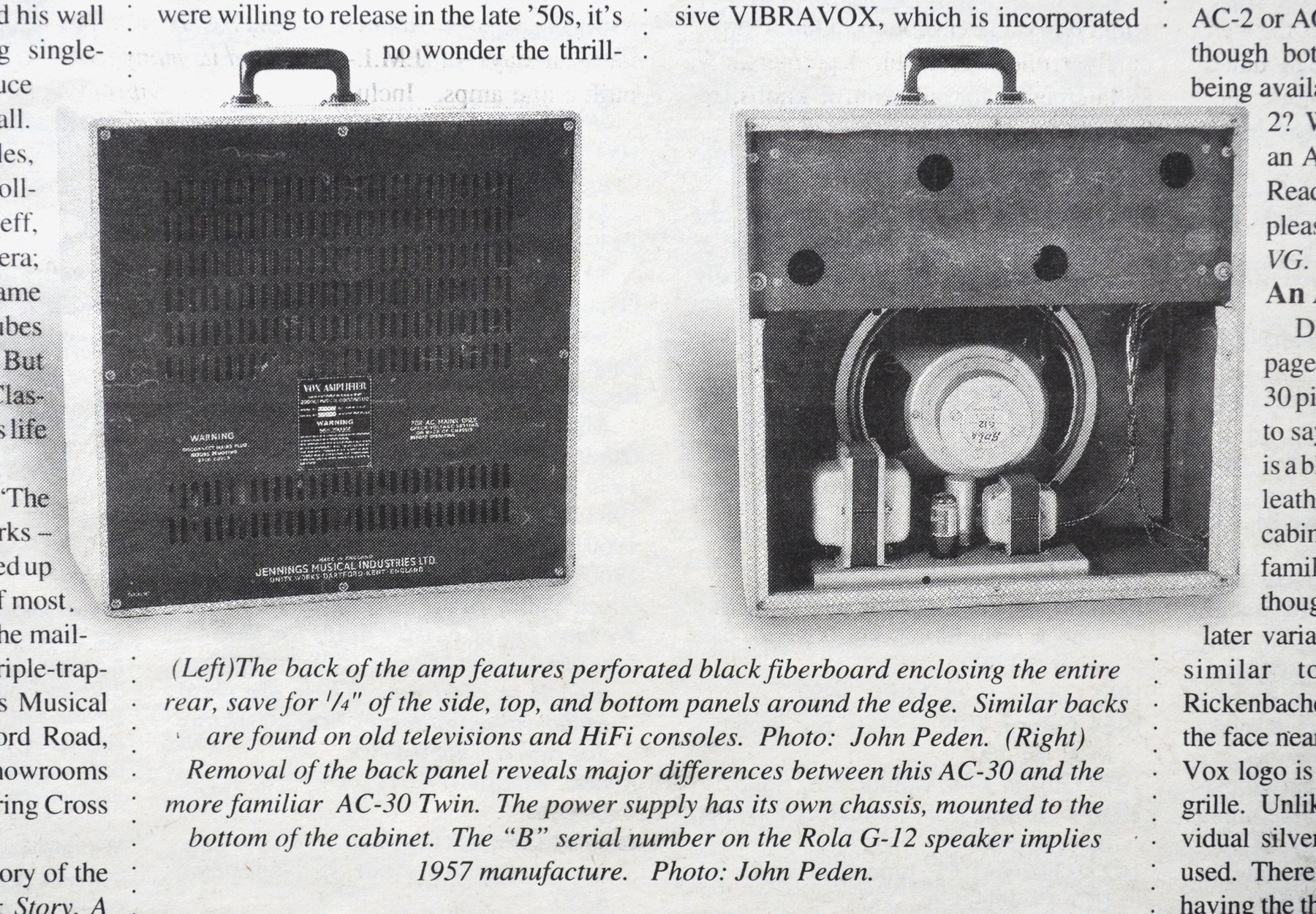The Vox AC/30 - summer 1959 to early 1960
Single speaker, 4 inputs, two EL34 valves; cathode bias.
.
An early advert for the AC/30
The AC30 in a new format: its cabinet and styling borrowed from the AC1/15, which had remained in production throughout 1958 and 1959. Tremolo and Vibrato come built in. There are no longer "standard" and "vibrato" models.
The amplifier chassis comprised of two parts: the preamp, with controls, at the top of the cabinet; the power section fixed at the foot. This was the standard arrangement of the day, employed also by Selmer and other manufacturers.
The AC/30 preamp section, which contained all the valves except the rectifier, was initially a modified AC1/15 chassis. See the pictures of surviving amps towards the foot of this page. In early 1960 a dedicated AC/30 preamp was designed and put into production.
Notes on the changing design of the preamp assembly can be found on this page. Certain amplifiers were built with enhanced functionality: the Vibravox circuit could be unplugged and plugged to allow a Vox piano control unit to be connected.
The flyer below (from which the detail at the head of this page comes) is likely to have been printed in the summer of 1959 specially to advertise the new amp. An earlier version promotes and illustrates the AC2/30.
Summer 1959.
Reverse.
The schematic of the single speaker dual-chassis AC/30 amplifier is OS/007 was drawn out on 1st January 1960. Certain elements changed (or were variable) as production proceeded.
Detail from OS/007.
Taps are provided on the mains transformer for 200/210v, 220/230v, and 240/250v. It should be remembered that supply voltages in the UK varied considerably from place to place in the 1950s, sometimes also into the late 1960s. Parts of Bristol still had 210v in 1969.
In company with the second circuit AC15, sales to the USA were evidently not envisaged. The AC1/15 by contrast made provision for operation in the States - see this page.
The power chassis of the new AC/30 was housed at the foot of the cabinet, the preamp at the top. The complement of valves was: POWER SECTION - GZ32 rectifier (later a GZ34), and two EL34s in cathode bias. PREAMP - three ECC83s and one ECC81 (the phase inverter).
Although the pair of EL34s were easily capable of delivering more than 30 watts, power had to be constrained - the single speaker was the limiting factor. It was still extremely rare in 1959/1960 for a 12" speaker to handle more than 15 watts. This at any rate was the power handling of the speakers chosen by JMI - either the Goodmans Audiom 60, or the Celestion G12.
The semi-closed back or the cabinet, normally made of brown or black perforated fibreboard (again, as in the case also of early Selmer amps), gave some degree of extra protection to the speaker, increasing safe power handling to over 20 watts.
OS/007 - the cathode bias of the EL34s - 470R resistors bypassed with 50mfd capacitors. 470R was the value of resistor recommended by Mullard in its specimen cathode bias circuit and 375v the recommended HT (see any EL34 data sheet.) It is likely that the AC/30 in actual fact produced less than 30 watts.
In late 1959 / early 1960, only a few months after the AC/30 had been put into production, Denney and Underdown started work on what was to become the single chassis AC30, trying EL34s at first, then moving to four EL84s. This new design, or rather format, was to become the AC30 Twin (first advertised in May 1960).
Back panel
On the back of serial number 4052 the legends stencilled in white are: "Made in England, Jennings Musical Industries Ltd., Unity Works – Dartford – Kent – England". At the bottom, centre: “Warning, Disconnect Mains Plug Before Removing Back Cover". On the left side: "For AC Mains Only". Right-hand side: "Check Voltage Setting On Back Of Chassis". At the bottom of the panel on the left-hand side:"Serial No." though no number is supplied.
The details above come from John Teagle's interesting piece published in "Vintage Guitar " magazine, May 1998 - available here. See also the pictures towards the end of this page.
Serial number 4052's speaker is a Rola G12. The original cover, which still survives with the amplifier, is green with tan piping.
Documents
Below, June 1959, the AC2/30 still on offer in two versions - with and without vibrato, 62 and 70 guineas respectively.
June 1959.
The note in the "Accordion Times", June 1959, probably relates, as above, to the AC2/30 - two versions available. That "a 30-watt model CAN be supplied..." presumably indicates special order.
The new AC/30 - "Accordion Times" magazine, June 1959.
"Accordion Times" magazine, July 1959. The amplifier is not illustrated but described briefly: "4 inputs, 30 watts output, 70 guineas".
"Melody Maker" magazine, 31st October, 1959 - new guitars, including the Electronica Oval-Basso (the small image showing it in profile). The amplifier priced at 70gns is the new AC/30. This advert first appears on 10th October, 1959 (though lacking the profile representation of the electro-bass).
"Melody Maker" magazine, 14th November, 1959. A growing roster of artists, now including Cliff Richard, Marty Wilde, and the John Barry Seven. The AC30 - 30 watt output, 70 guineas.
"Melody Maker" magazine, 28th November, 1959, a detail from a Boosey and Hawkes advert. Dave Goldberg, noted as a Vox user in the ad. above this one, with what may be an AC/30.
1960
"Accordion Times" magazine, April 1960, the AC/30 (not described explicitly) being the amplifier priced at 70 guineas. Note the new style of Vibravox with an inset black control panel.
"Melody Maker" magazine, 30th April, 1960. The AC/30 now 79 gns. There is also a bass version at 85 gns.
Printed in "Vintage Guitar" magazine, May 1998, in relation to AC/30 serial no. 4052, a JMI pricelist, undated but doubtless mid 1960 given its correspondence with the advert placed in the "Accordion Times" below.
"Accordion Times", May 1960. The AC1/15 at 65 gns, the AC/30 at 79 gns. The amplifier at 100 gns is the new AC30/4 twin - see this page.
Detail from above.
"Banjo, Mandolin and Guitar Magazine", October 1960, still the AC/30 in its single speaker format. Note the logo/emblem lower left on the front grille, as in the illustration at the top of this section. Picture from this great blog.
In early 1960 the price of the AC/30 had gone up to 79 guineas.
Single speaker amplifiers.
At present, three amplifiers with serial numbers are known: 4041, 4052 and 4076, the sequence presumably beginning at 4000 or 4001.
Perhaps around 200 AC2/30s and AC/30s were made in total - ie. running from serial no. 4000 to around 4200. The last AC/30s will have had numbers overlapping those of the new TV Front twins.
Surviving amps
Serial number unknown - currently in the USA
The earliest AC/30 currently known, probably late 1959. Further details to come. Picture from Jim Elyea. p. 14.
Serial number 4041 - currently in the USA
Serial number 4047 - currently in the UK
Well used over the years, the original baffle replaced, and cream-coloured diamond-pattern rexine painted over. The output transformer is missing, but most of the other significant elements are still present. One of the pots has the date code "JG" - October 1959. Black WIMA Tropydur caps with "68" and "88" date codes (June and August 1958). The two unpainted oval areas are where the feet of the luggage-style handle were fixed (thanks to Valentin for indicating this), the rectangular area the bronze "Jennings" plaque. The serial number plate will have been mounted on the rear panel (as 4052 below). Thanks to Steve for pictures and info.
Serial number 4052 - currently in the USA
A great article - well worth reading - by John Teagle in "Vintage Guitar" magazine, May 1993. The amp has its original cover (which was priced separately in 1960) - see this page.
Changes from this point
A new type of open-frame choke; a batten across the back to support the pressed hardboard back panel; and a proprietary chassis (instead of ones designed for AC1/15s). The evolution of AC30 chassis design can be seen on this page. In some amps, Vibravox circuitry is hidden in cans, in others in a Fender-style "doghouse".
Serial number 4060 - currently in the USA
Serial number 4060 (?) - white trafolyte control panel. Pic. from J. Elyea, p. 374. On p. 187 he indicates that serial number 4060 has a trafolyte panel.
NEW
Serial number 4072 - currently in the USA
Recently (April 2024) come to light - pictures and further notes to be added shortly. In the preamp, black WIMA Tropydur capacitors with "109" = October 1959; green TCC electrolytics with "QF" = June 1959; and smaller TCCs with "QL" = November 1959. The speaker, a Rola Celestion B024 (G12), is dated 2nd February, 1960 (02BE) on its gasket.
The Vibravox can be unplugged and plugged back in again to allow a Vox piano control unit to be collected. The same functionality was built into an amp further down this page (the first of the "serial numbers unknown"). A page on the control unit can be found here.
Serial number 4076 - currently in the USA
Pictures from Jim Elyea's book. The covering is probably not original. The cabinet has an added compartment for the plug. Presumably portions of the back panel were cut away to allow access. As can be seen the speaker is a Celestion B024.
Serial number 4102
Recorded by Jim Elyea, p. 529.
Changes from this point
Tag-board rather than eyelet board again in the preamp; and a new type of mains transformer to provide for operation at 110v, 205v, 225v, or 245v; .
Serial number 4158
The tops of the Bulgin knobs fitted to the amp in the 1970s/1980s can just be seen in the pic. above. These have now been removed and cream Bulgin pointer knobs put in place for the time being.
Control panel. The Bulgin "cooker" knobs are not original to the amp.
Probably late autumn / early winter 1960, close to the end of the model's run. Some early TV Front AC30 Twins may have have made their first appearance in the high 4100s, but no genuine example is known at present.
In the preamp, TCC capacitors with date code "RC" = March 1960; one of the wirewound resistors has "RD" = April 1960; and the black WIMA Tropydur caps "20" and "50" = February and May 1960 respectively. The main TCC capacitor in the power section has "RC" = March 1960.
At some point before the late 1980s, the original diamond-pattern rexine of 4158 was painted over and the handle mounts and one face of the slider board done in a fetching day-glo orange. The other side of the board still has its original black (and can be flipped around if need be). The cabinet will be left as is and not "put back to stock".
A page of various details is being assembled here.
Thanks to Peter for info on the amp's existence. Details on the electronics to be posted in due course.
Serial number unknown - currently in the UK
Recovered in thick black vinyl, orange visible underneath. The speaker is now a modern Celestion greenback. The upper chassis has a "laydown" transformer and a small plinth for the first of the vibrato cans. Underchassis electronics in good condition. One of the green TCC capacitors presents the date code "QM" = December 1959.
Serial number unknown - currently in the UK
Picture from some time ago. The amp still has its "THIRTY" runner lower left on the front.
Serial number unknown - whereabouts unknown
Sold by Ampaholics a good while ago.

































































